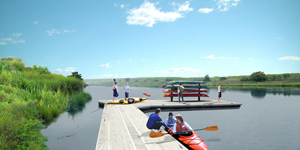Status: Under construction
 |
| Image courtesy James Corner Field Operations/City of New York |
In 1948, the City of New York opened the 2,200-acre Fresh Kills Landfill along a marshy shore of Staten Island. By 1955, it was the world’s largest waste depository — a claim to fame that infuriated the borough’s residents, who lobbied fiercely to close the stinky dump. At its peak, 29,000 tons of trash arrived daily.

Environmental regulations ultimately led to the landfill’s closure in 2001. That same year, the city put forth an ambitious proposal to transform the site into a beautiful green space that would be almost three times as large as Manhattan’s 843-acre Central Park. A design competition was launched, and six teams were invited to conceive a master plan.
Then September 11 hit. In need of a place to store debris from the World Trade Center site, the city reopened Fresh Kills. Workers sifted through 1.2 million tons of material, eventually burying it in a 48-acre parcel, and the landfill was closed again in July 2002.
Planning for Freshkills Park, amazingly, never stopped. In December 2001, the city announced three competition finalists, and in 2003, it chose James Corner Field Operations.
The firm’s scheme showed playing fields, bike paths, and equestrian trails, among other features. While praised, the plan endured years of environmental planning, and construction didn’t begin until spring 2010. The project will take 30 years to complete, at a reported cost of $1.4 billion. “This is the largest landfill-to-park transformation in the world,” notes Freshkills Park administrator Eloise Hirsh. Residents will finally see some results later this year, when a new playground and a cluster of basketball and handball courts opens. In 2012, work is scheduled to begin on a 3.3-mile bike path and the restoration of a 2-acre wetland area.
The plan is essentially divided into five districts. At the park’s center is the 70-acre Confluence zone, which contains streams, a small marina, a restaurant-lined promenade, and an open-air market. The other districts will be built atop four capped trash mounds, ranging in height from 90 feet to 225 feet: South Park will include a track, equestrian facilities, playing fields, and event spaces; North Park will offer hiking and biking and a tree nursery; East Park will have a large meadow; and West Park, where the Ground Zero remains now lie, will feature a September 11 memorial.
The lion’s share of the project has yet to be funded. The city has committed only $160 million, a downgrade from the $200 million it initially promised in 2006. Hirsh remains hopeful, noting that New York is dedicated to revitalizing land that has fallen into disuse. “The city has taken this kind of restoration to be part of its central civic mission,” she says.

Post a comment to this article
Report Abusive Comment